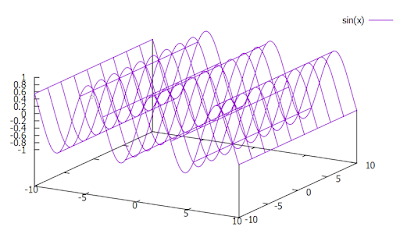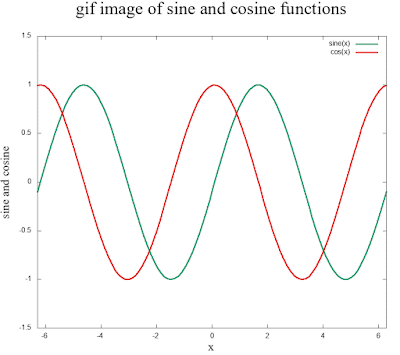derivatives of trigonometric functions - sinx, cosx, tanx, cotx, secx, cosecx and so on.
sin(x), cos(x) and tan(x) are basic trigonometric functions. cot(x), sec(x) and cosec(x) can derived from three basic trigonometric functions.
`tan(x) = \frac{sin(x)}{cos(x)}`
`cot(x) = \frac{1}{tan(x)} = \frac{1}{\frac{sin(x)}{cos(x)}} = \frac{cos(x)}{sin(x)}`
`sec(x) = \frac{1}{cos(x)}` and
`\cosec(x) = \frac{1}{sin(x)}`
This post provides you very useful ideas to find out the derivatives of these trigonometric functions by using the first principle of limit or limit theorem.
To learn basic concept of derivatives, go to the post.
Derivative of function f(x) w.r.t x by using limit theorem:
`\frac{d (x)}{dx} = \lim_(\Deltax->0) \frac{f(x+\Deltax) - f(x)}{\Deltax}`
1. Derivative of sin(x):
Let, `y = f(x) = sin(x) .....(1)`
Also, let `\Deltax` and `\Deltay` be small increments (increase or decrease) in x and y respectively. Then
`y+\Deltay = sin(x+\Delta) ......(2)`
Subtract (1) from (2),
`\Deltay = sin(x+\Deltax) - sin(x)`
Dividing both sides by `\Deltax`,
`\frac{\Deltay}{\Deltax} = \frac{sin(x+\Deltax) - sin(x)}{\Deltax}`
Now derivative of y w.r.t x as `\Deltax ->0` is,
`\frac{dy}{dx} = \lim_(\Deltax->0)\frac{\Deltay}{\Deltax}=\lim_(\Deltax->0)\frac{sin(x+\Deltax)-sin(x)}{\Deltax}`
Using the realtion,
`sinA - sinB = 2sin(\frac{A-B}{2}) cos(\frac{A+B}{2})` you get,
`sin(x+\Deltax)-sin(x) = 2sin(\frac{\Deltax}{2}) cos(\frac{2x+\Deltax}{2})`, so now
`\frac{dy}{dx} = \lim_(\Deltax->0) \frac{2 sin(\frac{\Deltax}{2}) cos(\frac{2x+\Deltax}{2})}{\Deltax}`
or, `\frac{dy}{dx} = 2\lim_(\Deltax->0) \frac{sin(\frac{\Deltax}{2})}{\frac{\Deltax}{2} \cdot 2} cos(\frac{2x+\Deltax}{2})`
But, `\lim_(\Deltax->0)\frac{sin(\Deltax)}{\Deltax} = 1` so,
`\frac{dy}{dx} = 2\lim_(\frac{\Deltax}{2}->0)\frac{sin(\frac{\Deltax}{2})}{\frac{\Deltax}{2} \cdot 2} cos(\frac{2x+\Deltax}{2})`
or, `\frac{dy}{dx} = 2 \cdot \frac{1}{2} \cdot 1 \cdot cos(\frac{2x+0}{2})`
or, `\frac{dy}{dx} = cos(\frac{2x}{2}) = cos(x)`
`\therefore` `\frac{d sin(x)}{dx} = cos(x)`.//
similary you can get, `\frac{d sin(ax)}{dx} = acos(ax)`.
2. Derivative of cos(x):
Let, y = f(x) = cos(x) ...(1)
Also, `y+\Deltay = cos(x+\Deltax) .....(2)`
Subtract (1) from (2),
`\Deltay = cos(x+\Deltax)-cos(x) `
or, `\frac{\Deltay}{\Deltax} = \frac{cos(x+\Deltax) - cos(x)}{\Deltax}`
Here using, `cos(A) - cos(B) = 2 sin(\frac{A+B}{2}) sin(\frac{B-A}{2})` ,
`cos(x+\Deltax)-cos(x) = 2 sin(\frac{2x+\Deltax}{2}) sin(\frac{-\Deltax}{2})` so,
`\therefore` `\frac{dy}{dx} = lim_(\Deltax->0)\frac{2 sin(\frac{2x+\Deltax}{2}) sin(-\frac{\Deltax}{2})}{\Deltax}`
or, `\frac{dy}{dx} = 2 \lim_(\Deltax->0)\frac{-sin(\frac{\Deltax}{2})}{2\frac{\Deltax}{2}} sin(\frac{2x+\Deltax}{2})`
Muliply the value in limit by `\frac{1}{2}` then,
`\frac{dy}{dx} = 2 \lim_(\frac{\Deltax}{2}->0)\frac{-sin(\frac{Deltax}{2})}{2\frac{\Deltax}{2}} sin(\frac{2x+\Deltax}{2})`
or, `\frac{dy}{dx} = 2 \frac{-1.1}{2} sin(\frac{2x+0}{2})`
or, `\frac{dy}{dx} = -sin(x)`
`\therefore` `\frac{d cos(x)}{dx} = -sin(x)`
Similarly you can prove,
`\frac{d cos(ax)}{dx} = -a sin(ax)` //
3. Derivative of tan(x):
Let `y = f(x) = tan(x) ......(1)`
Also, `y+\Deltay = tan(x+\Deltax) ........(2)`
Subtract (1) from (2),
`\Deltay = tan(x+\Deltax) - tan(x)`
or, `\Deltay = \frac{sin(x+\Deltax)}{cos(x+\Deltax)} - \frac{sin(x)}{cos(x)}`
or, `\Deltay= \frac{sin(x+\Deltax) cos(x) - sin(x) cos(x+\Deltax)}{cos(x+\Deltax) cos(x)}`
Using, sin(A - B) = sinA cosB - sinB cosA, so
`\Deltay = \frac{sin(x+\Deltax - x)}{cos(x+\Deltax) cos(x)}`
or, `\Deltay = \frac{sin(\Deltax)}{cos(x+\Deltax) cos(x)}`
Divide by `\Deltax`,
`\frac{\Deltay}{\Deltax} = \frac{sin(\Deltax)}{\Deltax \cdot cos(x+\Deltax) cos(x)}`
Now taking liit as `\Deltax ->0` on both sides,
`\frac{dy}{dx} = \lim_(\Deltax->0)\frac{\Deltay}{\Deltax} = lim_(\Deltax->0) \frac{sin(\Deltax)}{\Deltax} \cdot lim_(\Deltax->0) \frac{1}{cos(x+\Deltax) cos(x)}`
or, `\frac{dy}{dx} = 1 . \frac{1}{cos(x) cos(x)}`
or, `\frac{dy}{dx} = \frac{1}{cos^2(x)} = sec^2(x)`
`\therefore` `\frac{d tan(x)}{dx} = sec^2(x)`
Similarly, `\frac{d}{dx} tan(ax) = \frac{d}{dx} tan(ax+b) = a sec^2(x)`
Where a and b are constants.//
4. Derivative of cot(x):
Let, y = f(x) = cot(x) ........(1)
Following the same steps as in case of tan(x) using the relation
cos(A-B) = cosA cosB + sinA sinB, you get
`\frac{d}{dx} cot(x) = -cosec^2(x)`
Similarly, `\frac{d}{dx} cot(ax) = \frac{d}{dx} cot(ax+b) = -a cosec^2(x)`//
5. Derivative of sec(x):
Let, `y = f(x) = sec(x) = \frac{1}{cos(x)} ......(1)`
Also, `y+\Deltay = \frac{1}{cos(x+\Deltax)} .....(2)`
Subtract (1) from (2),
`\Deltay =\frac{1}{cos(x+\Deltax)} - \frac{1}{cos(x)}`
or, `\Deltay = \frac{cos(x) - cos(x+\Deltax)}{cos(x) cos(x+\Deltax)}`
Using the relation, `cosA - cosB = 2sin(\frac{A+B}{2}) sin(\frac{B-A}{2})` you have,
`cos(x) - cos(x+\Deltax) = 2 sin(\frac{2x+\Deltax}{2}) sin(\frac{\frac{\Deltax}{2}}{2})` so
`\Deltay = \frac{2 sin(\frac{2x+\Deltax}{2}) sin(\frac{\Deltax}{2})}{cos(x+\Deltax) cos(x)}`
Now divide by `\Deltax` and take limit on both sides as `\frac{\Deltax}{2} ->0`,
`\frac{d y}{dx} = \lim_(\frac{\Deltax}{2}->0) \frac{2sin(\frac{2x+\Deltax}{2}) sin(\frac{\Deltax}{2})}{cos(x+\Deltax) cos(x) 2\frac{\Deltax}{2}`
Using `\lim_(\Deltax->0) \frac{sin(\Deltax)}{\Deltax} =1`,
`\therefore` `\frac{d y}{dx} = \lim_(\frac{\Deltax}{2}->0) \frac{\Deltay}{\Deltax} = 2 \frac{sin(\frac{2x}{2})}{2cos(x+0) cos(x)}`
or, `\frac{dy}{dx} = \frac{sin(x)}{cos(x) cos(x)} = sec(x) tan(x)`
Thus, `\frac{d}{dx} sec(x) = sec(x) tan(x)` //
6. Derivative of cosec(x):
Let, `y =f(x) = cosec(x) = \frac{1}{sin(x)} ....(1)`
Following the same process as in sec(x), you get,
`\frac{d}{dx} cosec(x) = - cosec(x) cot(x)` //
Learn different rules of determining derivatives of different types of functions from HERE.








Comments
Post a Comment